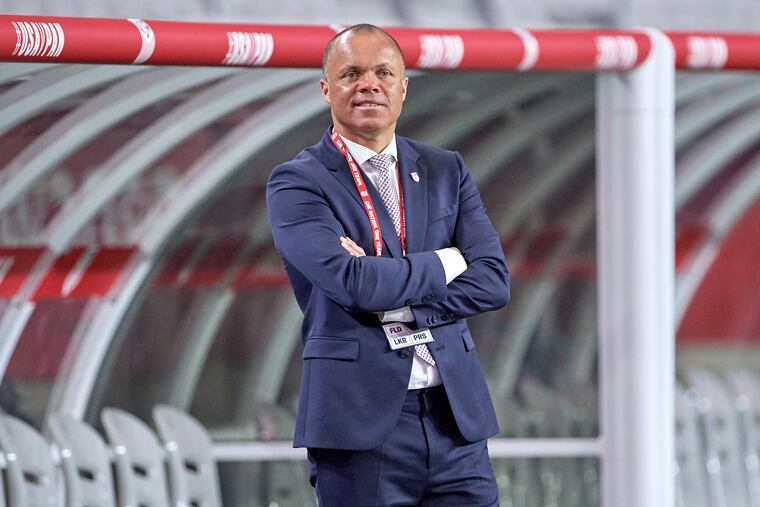Vlatko Andonovski’s USWNT won’t be as tactically rigid as Gregg Berhalter’s men
"The women are the best in the world, so they can be a little bit more adaptable to certain things," said U.S. Soccer Federation sporting director Earnie Stewart, who oversees both programs.

The hiring Monday of Vlatko Andonovski to coach the U.S. women’s soccer team isn’t just general manager Kate Markgraf’s first big move in the job. It’s also Earnie Stewart’s first significant involvement with the women’s program since his promotion from men’s team GM to U.S. Soccer Federation sporting director, which gives him oversight of both the men’s and women’s programs.
As the men’s GM, Stewart worked closely with coach Gregg Berhalter to lay out a long-term vision for the men’s team that included an attempt to establish a clear playing style. The subject has fascinated observers of American soccer for years, including those who think a senior national team should value results first and aesthetics second.
While Stewart and Berhalter’s plans might pay off in the long term, there have been some disastrous games in the short term. Since July, Berhalter’s team has lost to arch-rival Mexico twice, and earlier this month lost to northern neighbor Canada for the first time since 1985.
And it wasn’t just the final scores that resonated. Mexico has better talent and Canada has a rising young core, and they earned their wins. What really stung was how the Americans were too often out-thought and out-hustled.
Berhalter has given his players a complex playbook, and short national team camps don’t have much time to train on it. He also has insisted that his players play out of the back no matter the opponents’ defensive pressure. When Mexico saw that, it promptly dialed up the heat and ran the U.S. over.
Stewart hasn’t had as big of a day-to-day role in the women’s team as he’s had with the men’s team, and he’s going to hire a new men’s team GM to take on some of his duties.
But given Stewart’s title, it seemed fair to ask if Andonovski will be held to the same rigid tactical standards as Berhalter. In an interview Monday, Stewart gave a direct answer: No.
“It depends on where you come from,” he said. “And that is the women are the best in the world, so they can be a little bit more adaptable to certain things; and the men aren’t the best in the world, but they want to be to become the best in the world.”
Stewart watched Monday’s event from the back of the room, instead of being on the podium. But he was there, which had been a little bit in question since the U.S. under-17 team is playing at its age-group World Cup right now. And he didn’t hesitate to make the rounds on the record after the news conference ended.
“If you at the moment are building a program and developing, trying to develop talent, you can change every single week, but it’s not going to help,” Stewart said. “And that is not something that I believe in. It’s not something that Gregg believes in.”
As such, Stewart added, the “consistency and continuity” that he and Berhalter think the men’s team requires aren’t as necessary for the women’s team.
“I think those are two different elements of where they sit at this moment,” Stewart said.
This is not to say Andonovski’s teams won’t play with a defined style. They certainly will.
“The way I envision this team going forward is playing an attacking style of soccer, with using possession as a tool to unbalance defenses, to create goal-scoring opportunities and ultimately score goals,” he said at a Q&A session with fans held after the news conference. “I envision this team as a team that can control opponents — whether we’re in possession or out of possession, be able to control — and in short, I envision this team as attacking. I envision them as aggressive.”
But he won’t be constrained to the specific kind of 4-3-3 that Berhalter plays, with its inverting outside backs, dual No. 10s, and so on.
“When you watch any of Vlatko’s teams, and especially when some of his teams [were] without some of his key players due to injuries or World Cup call-ups, you always saw a very consistent thing: They like to have the ball, they’re very sound defensively, and they attack creatively,” Markgraf said.
“They do that by trying to create overloads or positional advantages, or trying to create different opportunities from various pockets of space that he’s identified from opponents, and capitalize on that with player movement or positional play. I think that’s very consistent across the board, it’s just a matter of execution and how it looks, the strategies which you employ in order to achieve your objective.”
If you aren’t a soccer coach, that might all sound like a lot of jargon. The simpler version came from U.S. Soccer Federation president Carlos Cordeiro, And as it so happened, it came in his introductory remarks that day.
“Vlatko is known for his deep understanding of the game, his unmatched preparation and his tactical flexibility,” Cordeiro said. “Frankly, I can’t imagine a more perfect match than this coach for this team at this moment in time.”
Nor can many others. And unless Berhalter rights the ship soon, the contrast between his team and Andonovski’s will remain in the spotlight.